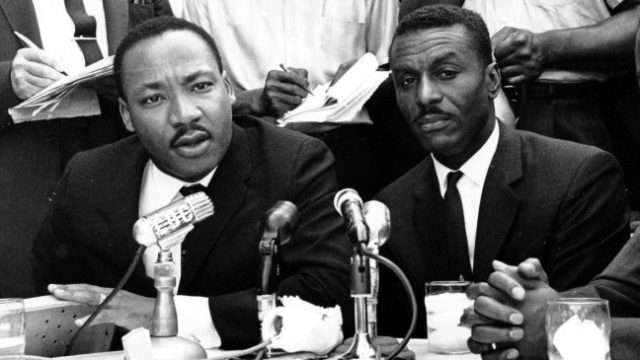By Barnett Wright
The Birmingham Times
None other than Forbes.com recently listed Birmingham as one of its top affordable winter 2020 destinations, an acclaim that’s notable given how far the city has come—especially with race relations and Civil Rights—since its birth in 1871.
The Magic City made the list along with U.S. cities like Chicago, Ill., and San Diego, Calif., and international locales including Mexico City, Mexico; Rome, Italy; and Cartagena, Colombia.
“This Alabama destination is growing in popularity and for good reason,” the site says. “Its cultural roots combine effortlessly to produce an amazing food scene, where high-end culinary chops meet down-home flavors. In addition to the restaurants helmed by James Beard Award–winning chefs, you’ll also enjoy a delightful art scene.”
Forbes isn’t the only media publisher to take notice of the Magic City. The Birmingham Business Alliance (BBA) tracks accolades, or positive mentions by national outlets, and reveals that 2020 is already off to a strong start with mentions of the city by CNN and Entrepreneur magazine, in addition to the Forbes shoutout. Those come on the heels of a “record breaking year for [accolades]” in 2019, when the city amassed 53 in total, according to the BBA.
It hasn’t always been that way, though. There was a time when mentions about Birmingham were mostly negative, and even today no one argues that much more still needs to be done.
To kick off Black History Month, the Birmingham Times takes a look back at the Magic City’s early years through 1963 to show how the city arrived at the momentous and historic Civil Rights Movement that was transformative for not only the city but also the world.
Here are some significant years in that history.
1871
Birmingham was incorporated into Jefferson County on Dec. 19, 1871, with an estimated population of 800. The new city was built on a parcel of land bought from the Elyton Land Co. and located in the county’s sparsely settled hill country, an area avoided by enterprising farmers because the soil was unsuitable for the staple crops of corn and cotton. There had been a hint of the future in the area’s crude industrial furnaces, used during the Civil War to produce pig iron for the Confederate arsenal at Selma. The city was founded at the crossing of two rail lines near one of the world’s richest deposits of minerals and named for Birmingham, England, the center of that country’s iron industry. African Americans began moving into Birmingham to escape the white-owned farms where they had once toiled as slaves and later as sharecroppers.
1873
Early in 1873, the Elyton Land Co. donated land to the city for its first public school, but there was a catch. The deed specified how the Free School—its name, although a nominal fee of $1.50 was charged per year to reduce the debt associated with the school—was to be utilized: “To have and to hold to the Mayor and the Aldermen of Birmingham in trust as follows. For the use and purpose of erecting a schoolhouse and school buildings … for the purpose of a free school for the white children now residing in and who may reside hereafter in said city for no other purpose and use whatever. The school is to be taught by white teachers.”
The city responded to a petition for support from the black community in 1877 by paying to hire a teacher for a school bought and supplied by civic-minded blacks. By 1885, however, neither of the two black schools then existing offered more than six years of instruction; white children could complete the 11th grade.
1880s and 1890s
Education
The building of schools for blacks had roughly kept pace with buildings for whites, though the black facilities were demonstrably inferior. The expansion of schools in the first decade of the 20th century would bring virtually no benefits to the black community. According to one historian, “It was almost as if the Board of Education completely forgot about them.”
In 1907, Birmingham Mayor George Ward observed, “The Negroes are not as well provided for now as they were 10 years ago.” No new school had been built for blacks between 1891 and 1907, while the Thomas School for Negroes in East Birmingham had burned in the mid-1890s, causing 1,000 pupils to stop attending. The Board of Education had collected insurance for the school but had not replaced it. Instead, the board rented space in the basement of a neighborhood church, a location that frequently flooded, resulting in classes being dismissed for days at a time. The Birmingham News commented, “The place is a menace to the public health, and if it were a private house would long since have been condemned as a nuisance.”
Labor
By 1880, African Americans comprised more than half of Birmingham’s industrial workers. Working and living conditions were bad enough, but the lives of black citizens were made more miserable by the city’s deeply entrenched system of segregation. The racial division of labor was stark—skilled craftsmen were all white; unskilled workers, with few exceptions, were black and unorganized—and the introduction of the steel mills in the area at the turn of the century began to undercut the positions of both skilled craftsmen and unskilled workers.
1890
Birmingham’s black populace was virtually excluded from active participation in politics in Alabama. Locally, blacks had been barred from municipal politics in 1890, when the state’s white Democratic Party rose to power. Blacks voted in state and national elections until the “disenfranchising constitution” of 1901—the document still used by Alabama’s lawmakers—which included “the most complicated and undemocratic suffrage article in the United States.” Of the 5,420 voters registered by officials during the spring of 1902, only 76 were black.
Banking
The Penny Savings Bank, founded by the Rev. William Reuben Pettiford in Birmingham in 1890, was the first black-owned and black-operated financial institution in Alabama. Created as a necessity of de facto and later codified segregation, the bank backed and encouraged development of black businesses, especially in urban areas, as well as savings by African Americans, until its closing in 1915.
1891
St. Mark’s School (originally St. Mark’s Industrial and Academic School for Colored Girls and later St. Mark’s Academic and Industrial School) was a private institution founded in 1891 by St. Mark’s Episcopal Church; it was the first school in Birmingham to offer secondary education to black students. The parish began teaching a small group of eight students with two female teachers, both white, who came to Birmingham from New York and Michigan. The school’s large four-story brick building, completed in 1892, was located at 18th Street and Avenue C on the Southside. St. Mark’s originally accepted only female students, many of whom boarded at the school.
1903
Social worker Carrie A. Tuggle opened the Tuggle Institute and School, the first orphan home in Alabama for African American boys and forged a partnership with Birmingham City Schools in 1926. After the Institute was forced to close in 1933, the Birmingham Board of Education purchased the 15-acre site and its 13 structures. Enon Ridge School, opened in 1934, was renamed in 1936 to honor Tuggle, who is buried on the school’s grounds.
1905
Black citizens petitioned the Board of Education for improved facilities, expressing concern over racial prejudice in the allocation of school funds. The board, however, felt the petition to be “ill-advised” and “a practical insult.”
1907
Mayor George Ward joined the black community in pressing for improved school conditions. In his 1907 annual message he wrote, “It appears to me that we are not doing our duty to the Negro population in the matter of school facilities.”
1910
Initially, parks had been used by blacks and whites alike when the city system was established in 1883. After 1910, however, blacks were not allowed in any of the parks except as servants, unless specifically granted permission by the city commission. Until 1910, although neither local nor state law required segregation in public transportation, the streetcar company separated blacks and whites, often with partitions. That year, the council made official the customary practice by enacting a Jim Crow streetcar law.
Health
Statistical data about the entire population of Birmingham are somewhat misleading because they fail to recognize the vast differences between services and conditions in black and white communities. Consider Birmingham’s death rate at the time, for instance. This single figure masks the fact that whites in Birmingham, as in most other southern cities, consistently had a death rate that was about one-half the rate among blacks—the black death rate from tuberculosis of 349 deaths per 100,000 citizens was four times the white rate. “In every area where information is available, it is clear that the level of services and quality of life for black Birminghamians were significantly below the admittedly low standards for the community as a whole,” wrote Edward Shannon LaMonte in “Politics and Welfare in Birmingham 1900–1975.”
1920
Birmingham’s black citizens fared poorly when it came to municipal services. Part of the official attitude toward people of color can be explained by the virulence of the Ku Klux Klan (KKK) during the 1920s and its impact on local politics. The group grew in Jefferson County after 1916, and its numbers peaked in 1926, when there were between 15,000 and 20,000 active Klansmen in the county—including two local judges, the sheriff, most members of the Birmingham Police Department, and at least 20 other city and county officials. During the 1920s, aspiring politicians were compelled to honor, in word if not in deed, the KKK and its program of religious intolerance and racial bigotry.
1939
In January, unemployed workers formed an integrated committee to press for more aggressive local efforts to secure Works Progress Administration (WPA) projects in the area. When a delegation of five whites and two blacks called on the Jefferson County Commission president, he shouted, “I don’t care to discuss the matter with you. Don’t come in here with a mixed committee. Don’t bring Negroes in here on a committee.”
1947
For years, tensions ran high between the races in Birmingham. Violence increased as blacks began to move into areas that previously had been all white. Bombings in 1947 during a zoning conflict between blacks and whites in the North Smithfield area of Birmingham—which became known as “Dynamite Hill” for the number of bombs used to intimidate blacks moving into the neighborhood—established a pattern that spread across the South.
1954
Despite the momentous and unanimous Supreme Court Brown vs. Board of Education of Topeka (Kan.) decision in 1954, which stated that “separate educational facilities are inherently unequal” and made segregation in schools unconstitutional, Birmingham did not desegregate its schools until fall 1963. The city’s opposition to the Supreme Court’s decision was in lockstep with much of the rest of the South. Only two Southern states began desegregation in 1954: Texas in one district and Arkansas in two. Ten years after the Brown decision, only 1.17 percent of black schoolchildren in the 11 states of the former Confederacy attended school with white classmates.
1956
In May, the state of Alabama temporarily outlawed the National Association for the Advancement of Colored People (NAACP), which had championed rights and voting privileges since its founding in 1909. The Alabama Christian Movement for Human Rights (ACMHR) organized to fill this void. Led by the Rev. Fred Lee Shuttlesworth’s Bethel Baptist Church and 59 other black churches in the Birmingham area, the ACMHR’s membership of preachers, deacons, Sunday school teachers, secretaries, and blue-collar workers supported the organization with pennies or, at most, a dollar or two a week.
1961
Many of the activities by segregationists alarmed members of the Birmingham Chamber of Commerce, which began to consider reforming the government. Chamber members were increasingly dismayed by the inflammatory and inflexible actions of the pro-segregation city commission, and especially Birmingham Commissioner of Public Safety Theophilus Eugene “Bull” Connor, when it came to race relations.
Particularly offensive to business leaders was the Mother’s Day 1961 beating of Freedom Riders, Civil Rights activists who rode buses into the South to challenge the segregation of interstate transportation, at the city’s Trailways Bus Terminal. Most offended of all and destined to provide leadership for the reform effort was Sidney Smyer, president of the Birmingham Realty Co. and incoming Chamber of Commerce president in 1961. Smyer had been in Tokyo, Japan, at the International Rotary Convention when a picture of the beatings appeared in the Japanese press. As a result, Smyer found himself the object of cold stares and perplexed questions from his Japanese hosts and the assembled international businessmen, who had suddenly lost interest in Birmingham’s climate for investment.
Partly because of the international embarrassment, the chamber, with support from the Birmingham Bar Association, soon pushed for a change of government, recommending a strong Mayor-Council structure that would strip power from Connor and abolish the city commission style of governance.
1963
In the spring of 1963, local activists launched one of the most influential campaigns of the Civil Rights Movement: Project C, better known as The Birmingham Campaign, which would be the beginning of a series of lunch counter sit-ins, marches on City Hall, and boycotts on downtown merchants to protest segregation laws in the city. Over the next few months, the peaceful demonstrations would be met with violent attacks using high-pressure fire hoses and police dogs on men, women, and children alike—producing some of the most iconic and troubling images of the time. President John F. Kennedy would later say, “The events in Birmingham … have so increased the cries for equality that no city or state or legislative body can prudently choose to ignore them.” This period is considered one of the major turning points in the Civil Rights Movement and the “beginning of the end” of a centuries-long struggle for freedom.
Today
Since those troubled times, Birmingham has evolved. The downtown area that once served as a backdrop for violent reactions to peaceful protests, has emerged as a vibrant city center bolstered by nearly $1 billion in investments. Recently completed, proposed, or under construction projects include apartments, condos, hotels, a grocery store, retail and office space, entertainment venues, museums, and a brewery, in addition to a new parking deck and new facilities at the University of Alabama at Birmingham (UAB).
On the culinary scene, Birmingham ranks among the best in the U.S. In 2018, Highlands Bar & Grill in Birmingham was named America’s Most Outstanding Restaurant at the James Beard Foundation Awards in Chicago; its pastry chef, Dolester Miles, was also named best in the country, making the restaurant the runaway winner at the awards. A panel of chefs, restaurateurs, and food journalists gave Highlands chef and owner Frank Stitt’s modern Southern restaurant the honors. In addition, eateries such as Bottega, Hot & Hot Fish Club, and Café Dupont, as well as favorites Ocean, Overbird, and Dreamland Bar-B-Que, are often recognized among the best in the nation.
Local museums—including the Birmingham Civil Rights Institute, the McWane Science Center, the Birmingham Museum of Art, Vulcan Park and Museum, and the Barber Vintage Motorsports Museum—draw hundreds of thousands of visitors every year. UAB, the state’s largest employer, has 23,000 employees, more than 22,000 students, and a $7.15 billion impact on the community. And Southern Research, a contract research organization with more than 400 scientists and engineers, is making strides in drug discovery and drug development, as well as engineering, and energy and environment.
Innovation Depot, the Southeast’s largest technology incubator, which houses nearly 100 startups in its 140,000-square-foot facility in downtown Birmingham, has been named Technology Incubator of the Year and designated a Soft Landing for international companies by the National Business Incubation Association. Just last month, The Switch, a new brand for Birmingham’s Innovation District, was unveiled at Innovation Depot’s Velocity Accelerator kickoff event—complete with new branding and a website full of resources.
How far has the city come over the past 149 years?
The Switch is associated with the Civil Rights District and Fourth Avenue Historic Business District in a partnership that celebrates social innovation, inclusion, and equality. All three have teamed up to highlight different aspects of economic growth, business development, and opportunity—uniting a once-fragmented Birmingham and connecting it to the world.
Edward Shannon LaMonte, “Politics and Welfare in Birmingham, 1900-1975”; J. Mills Thornton III, “Municipal Politics and the Struggle for Civil Rights in Montgomery, Birmingham, and Selma”; pbs.org; www.bhamwiki.com; www.encyclopediaofalabama.org contributed to this article.




